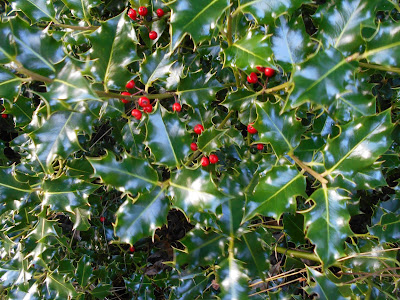In fact they share a curious feature.
Holly, Ilex aquifolium, is a member of the Aquifoliaceae family. It is not blessed with an enormous number of species - about four hundred species spread over three genera, with Ilex being overwhelmingly the largest genus. The family members are spread all over the world, particularly in the Americas but, and here is a surprising fact:
Holly is the only member of the Aquifoliaceae in Britain.
 |
Holly in the churchyard of St. Mary the Virgin, Woodford Halse.
20 December, 2018
|
Ivy, Hedera helix, belongs to a somewhat larger family, the Araliaceae with some 700 members. A large number of the family members are climbers and many are lianas. These are long stemmed, woody vines found in tropical and sub-tropical situations and many of them were probably utilised by Tarzan as, in old films, he swung from tree to tree in a variety of ludicrously improbable scenarios.
Ivy is the only member of the Araliaceae in Britain (although, to be fair, it is often split into two subspecies).
 |
Ivy climbs over a headstone in the churchyard of St Mary the Virgin,
Woodford Halse. Bonfire smoke billows in the background.
20 December, 2018 |
And then we come to Mistletoe, Viscum album. Here the situation is rather more complicated. Traditionally it has been placed in the Loranthaceae and this is the largest of the families under consideration, for it contains about 1000 members. But some botanists would place the Loranthaceae in the same family as the sandalwoods, the Santalaceae. This is a group of around 400 members which includes Sandalwood itself, Santalum album, giving the family a combined membership of around 1400 species. We do have a member of the Sandalwood family, the Bastard Toadflax, Thesium humifusum. ('Bastard' here is used in its original sense of being false.) In Britain it is rare, and is more or less confined to an area within about fifty miles of Southampton. Bastard Toadflax does not grow in Northamptonshire and I have never seen a wild plant.
Be that as it may:
Mistletoe is the only member of the Loranthaceae in Britain.
So each member of this trio of plants is the sole representative of a much larger, generally tropical, family and for my money, this makes them more interesting than any of their various connections with midwinter celebrations.
And once the festivities are over:
Down with the rosemary, and so
Down with the bays and mistletoe:
Down with the holly, ivy all
Wherewith ye dressed the Christmas hall.
Robert Herrick
No comments:
Post a Comment